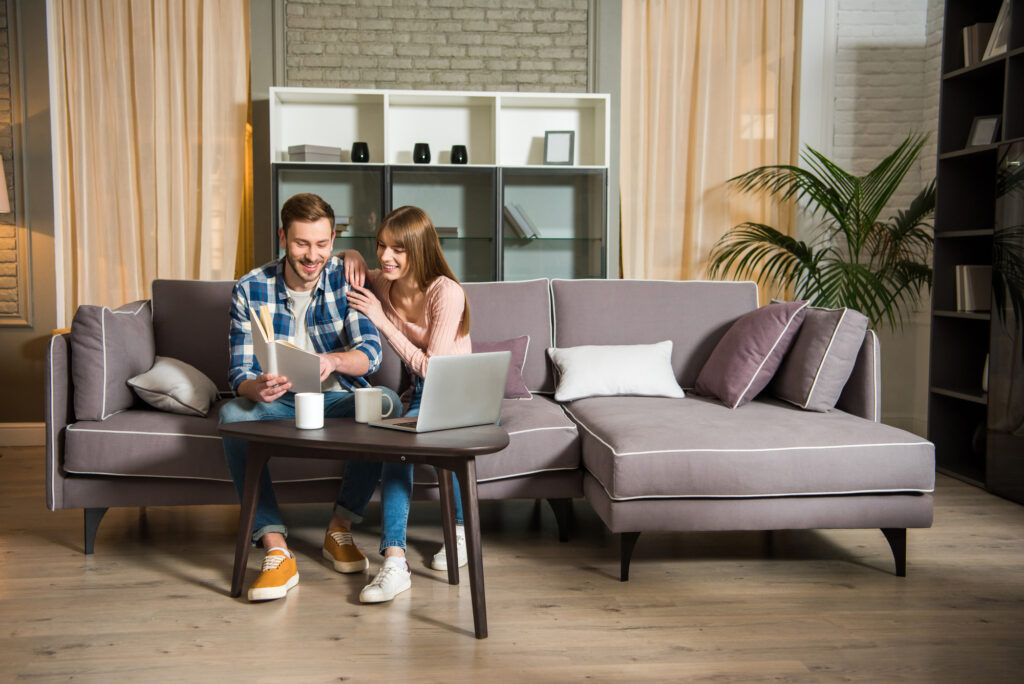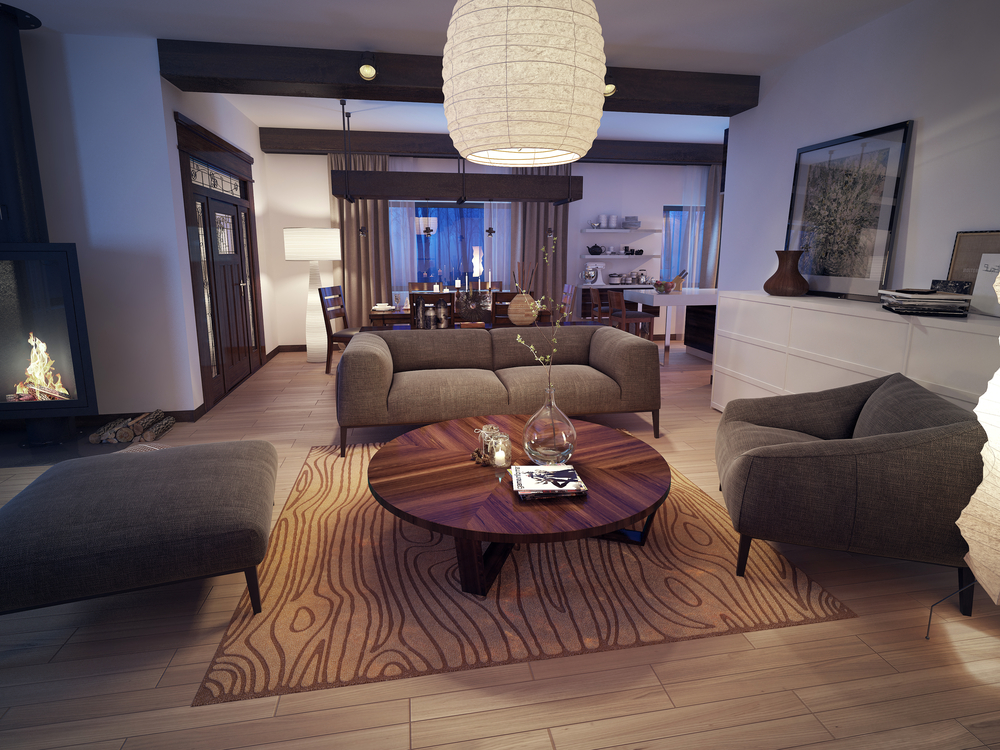
We expect more from today’s homes than ever before. The trend towards remote and hybrid work and study has been on its way for years and was not just a consequence of what happened in 2020 – although these events certainly hastened and accelerated the shift!
Modern living has challenged our preconceptions across every aspect of interior design, but nowhere has this change been more profound than in the living room.
A brief history of the living room
It is worth taking a moment to understand where we have come from to gain a clearer picture of where we are going. Like so many aspects of modern design, the concept of a living room as a place in the home for people to congregate and relax without formality originates in the palace of Versailles prior to the French Revolution.
Back in the 18th century, it was only the elite classes who had time for leisure – and in France, even their days were numbered. But 100 years later, the industrial revolution meant that everyone could enjoy a shift in their living patterns and living rooms became a central feature of even the most modest home. It was a place to enjoy those precious few hours that were occupied by neither labor nor sleep. Unsurprisingly, features like reading lamps, ash trays, card tables and often a piano became commonplace features according to the popular leisure activities of the time.
By the mid 20th century, radio and then television became important features of the living room. The TV, in particular, became a new focal point. Early sets, that were heavy but relatively compact with their nine to 12 inch screens, were typically housed in ornate cabinets, out of sight until it was time for the family to sit down together and switch on. In the 1990s, flat screen TVs came along, bigger, lighter and completely unsubtle, but still the focal point of most living rooms.
Since then, technology has continued to march on and other leisure trends have taken center stage. Streaming a movie or playing a multiplayer game are both more likely than playing the piano or having a card game, although these more traditional pursuits are by no means extinct. That in itself is no different from the shift in habits and hobbies between the 1950s and 1980s.
However, there is a more profound difference between the 1990s and today that means living rooms must adapt to more than a change in hobbies and leisure pursuits. From those earliest days when everyday home took inspiration from Versailles, the living room was a place for family members to congregate when the working day was done. It would be mostly unoccupied during the day, unless by retirees or pre-school children.
It is no coincidence that the new technological age is sometimes termed the third industrial revolution. Widespread automation and digital connectivity mean that millions can work and study without needing to leave their homes. More than that, though, flexible working and study practices have made the traditional 9-5 all but obsolete.

The role of the modern living room
Remote or hybrid work and study have made life easier, in the sense that many of us are now spared the inconvenience and cost of commuting and the hassle of deciding what to wear for work and whether to pack lunch. But easier does not mean any less complex.
The traditional 9 to 5 formed the main building block of what used to be a quite strictly timetabled day, around which we factored in meals and a few hours of leisure time spent in the living room in the evening.
Today, some family members might still follow strict work hours while others are more flexible, working early morning or late evening but enjoying leisure time during the day. Even those leisure pursuits are more fragmented. In the 1970s, most families would sit together and watch TV. Some might still do so, but people are equally likely to be chatting with friends via social media or playing a game on their phones, or reading a book or – as just mentioned – sitting with a laptop getting some work done.
Sure, many homes have adapted to changing times by having a dedicated home office or study. But that only gets you so far – a little like the hot-desking phenomenon that was fashionable in offices in the early 21st century, an office is more likely to be used for a specific task, such as to join a conference call. More than 50 percent of remote workers do not even have a desk to work from, and reading between the lines, it appears that many who do have one prefer to leave it and return to the sofa with their laptop when they have finished their call.
Add all this together, and you suddenly see a living room that must meet completely different needs to those of 20 or 30 years ago. It will usually be occupied most of the day, often by different people doing different things. However, it will still be the place where the family gathers to enjoy time together, although those gatherings will be less regular or predictable and more ad hoc.

Zoning – the way forward?
Some designers have suggested that the very notion of a living room is something that should be left behind in the 20th century. Instead, they recommend concentrating on maximizing living space as a whole, segregated into different zones where people can work, socialize, watch TV or read a book in solitude without getting under one another’s feet.
Shelving units, sofas, even something as simple as a rug can be used for the demarcation of different zones. The idea of sitting and working on a laptop while another family is just a few feet away in a different zone playing a video game might sound offputting. But try not to idealize the “old ways” too much – is your game-playing family member really any more distracting than the 40 or so people with whom many of us would share open-plan office space with their incessant chatter and phone calls?
A corner sofa is an ideal feature, as it can provide a comfy and sizeable zone that can occupy perhaps five people. It is also clear to delineate when accompanied by a rug and perhaps a square coffee table or foot stool.
There are many other ways of zoning an open-plan living area such as using different lighting in different zones, changes in floor surface or even split levels. That’s well and good in a large, airy, open-plan house. But what if you have a living room of more modest dimensions?
Even here, there are subtle ways of separating the room into zones. In fact, some of the top interior design experts, such as Rachel Ward, recommend zoning as a way to create the illusion of more space and to get optimum value out of a diminutive living room.
In a recent piece for UK interior design publication House Beautiful, she described how to zone a small living room into areas for work, hosting, wellbeing and family. She pointed out that we usually need no more than a comfy chair and a solid surface for a laptop in order to work. The chair can even be borrowed from another part of the house if space is really tight!
Curtains or storage dividers that are themselves multi-purpose and can be used to separate zones. But in really tight spaces, how’s this for an idea: A portable drinks trolley can be used as a border to the hosting area if you have guests and is also a fun and fashionable touch when it comes to offering refreshments.
Rachel advocates the use of houseplants in the wellbeing zone. They help us to stay connected to the natural world and on a more prosaic level, they do a great job of helping to tackle that very 21st century problem of indoor air pollution. Our homes are so well insulated these days that it can adversely affect air quality. A large leafy plant is great if you have room for it. If not, wall and ceiling mountings can pave the way for a hanging garden for the ages.

The office in a cupboard
We touched on this with Rachel’s idea earlier, but the notion of an office in a cupboard is such a clever one it bears closer evaluation. Much as in the 1950s and 60s the TV was seen as an intrusion into the living room, many people today are concerned that working from home means the family’s main gathering place is taken over by office paraphernalia. Yes, many of us work paper-free these days, but some of us don’t! The 20th century solution is an interesting take on those wooden TV cabinets with opening doors that our grandparents had.
By installing a home office inside a cabinet or an alcove, everything is contained in its own space and can be easily shut away out of sight when it is time to down-tools and relax. It’s not just for the work-from-homers, either. Youngsters can do what they need to do online, whether it’s homework or catching up with friends, without being shut away in their bedrooms. Whisper it, but it means parents can keep half an eye on what they are up to in cyberspace, too, which can be no bad thing.
Think carefully about seating if you take this approach, and ideally, choose a chair that either folds or will slide in under the desk and still allow the doors to be closed. The last thing your living room needs is an apparently lost office chair sitting lonely by a cupboard door.
Modular furniture – a glimpse of the future?
Back in 2014, Spanish furniture design studio Unamo caused something of a splash with its modular sofa bed that transforms into a chaise longue with side table or table with bench seats that can purportedly accommodate eight. Called the 3MOODS, it attracted plenty of media attention at the time, but the $14,000 price tag meant there were few buyers.
Today, one has to wonder whether designer Humberto Navarro was a man ahead of his time. Eight years later, modular designs from the likes of IKEA are all the rage and facilitate modern living in multipurpose spaces. Having said that, nobody has yet come up with anything quite like Unamo’s design!

Pay attention to lightning
The wonders of LED technology mean we have a world of alternatives at our fingertips when it comes to lighting. The days of a ceiling rose and a couple of table lamps are long gone, and you can install multiple types of lighting to match the multiple purposes of your living room.
Mood lighting at floor level is ideal for evenings. It creates a cozy atmosphere that is conducive to relaxing together as a family. Low hanging overhead globes look stylish over a dining area, and to return to an earlier theme, they are a great way of defining that zone of the living space. Finally, task lighting is exactly as it sounds, specific lights in specific areas that you can switch on as necessary for working, reading or maybe even having an old-fashioned game of cards around the card table.
The point is, lighting plays a vital role in setting the mood, so give this area plenty of thought. Also, keep in mind that although LEDs are more expensive to buy, they pay for themselves many times over with their long life and impressive economy. Resist the temptation to buy cheap alternatives, it is almost a dictionary definition of a false economy.






